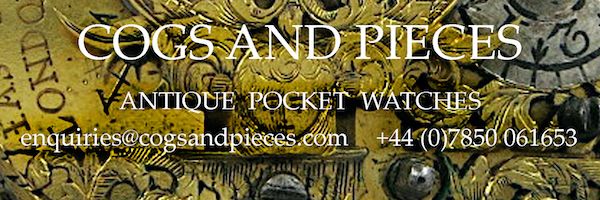Irish Gold Dumb Repeater
Stock No. 1408
John Crosthwaite
Dublin, 1790
Gold pair cases, 56.25 mm.
Cylinder escapement, quarter repeating movement
Sold
A substantial gold Irish dumb repeater, with fine cylinder escapement movement, in pair cases.
MOVEMENT : Gilt fusee movement, with beautifully engraved and pierced balance cock. Large diamond endstone, polished steel balance wheel, five round pillars, silver regulator disk and clean blued screws. Cylinder escapement with polished steel escape wheel.
Fully signed (Jn. Crosthwaite, Dublin) and numbered (1226). The movement is protected by a removable gilt dustcap, signed and numbered as the movement.
The quarter repeating movement strikes brass blocks fixed to the inner case, with 2 polished steel hammers. One tap for each hour, and a double tap for each quarter. The pulse piece is intact, and appears through the inner case at 8.
This movement is in exceptional condition, and is running well.
DIAL : Signed white enamel dial in reasonable condition, but with light hairlines around the edge, and more across the top between 11 and 1, and at 6. Small chip on the edge at 9.
Unusual and fine matching gold hands.
INNER CASE : 22ct. gold, with Irish hallmarks for 1790, maker OAN (Arthur O’Neil), and movement serial number (1226). The Irish mark is a crowned harp, with date letter S. All in good condition. The hinge is fine and the bezel snaps shut nicely. Crystal in good condition.
OUTER CASE : 22ct. gold, with marks matching the inner. In good condition, though possibly signs on the inner rim of an old repair. A few scratches and small bruises.
The hinge, catch and catch button are all fine and the bezel snaps shut correctly.
The gold cases are quite substantial, with a total gold weight of 75 gms., excluding crystal.
Most gold and silver watches of this period from Irish makers are cased in English hallmarked cases. It is unusual to find a case with Irish marks.
John Crosthwaite is listed in Dublin between 1760 and 1800, and later in partnership with his son.
PROVENANCE : From the collection of the late William Hughes (1922-2017), Bowral, Australia.
Philanthropist and entrepreneur, William Hughes frequently travelled to Europe and the United States of America. Fascinated by their design and movement, Hughes became a collector of pocket watches later in his life, often collecting pieces during his extensive travels.

















